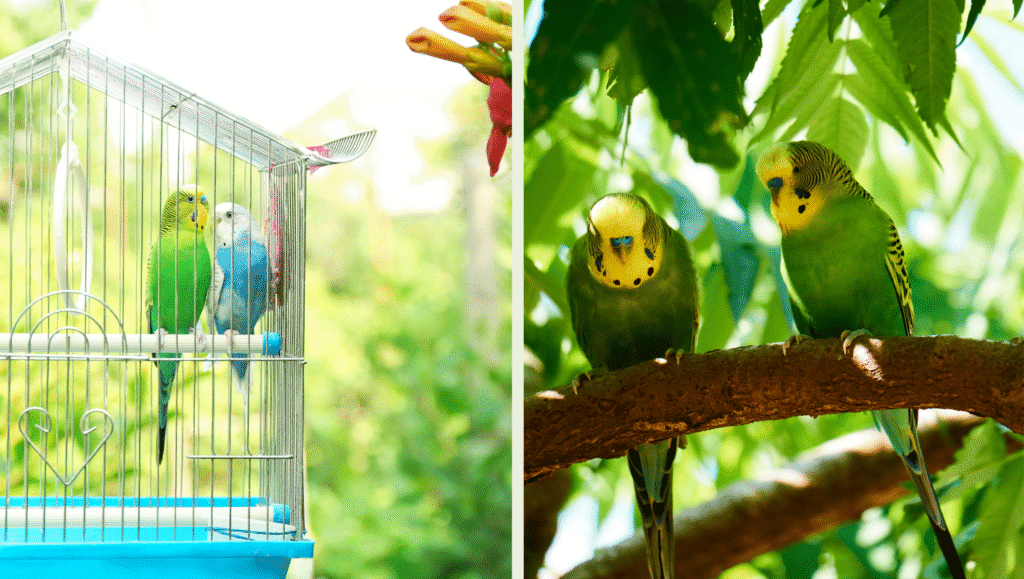How Long Do Budgies Live? Lifespan in Captivity vs. Wild
- Admin

Categories
Don’t miss our future updates!
Get Subscribe today!
Pet Budgie lifespans vary widely: wild budgerigars often live 2–4 years, while well‑cared‑for captive budgies can reach 10–15 years. This article examines why and how to help your pet budgie live its longest, happiest life.
Understanding Budgerigars: From Australia to Your Home
What Is a Budgie?
Budgerigars (commonly called budgies or parakeets) are small, colorful birds native to Australia. They’re known for their playful behavior, mimicry, and strong bonds with owners.
Why Budgies Are Popular Pet Birds
Budgies score high in the pet bird world thanks to their manageable size, engaging personalities, and moderate life expectancy. They’re ideal for beginners and experienced bird keepers alike.
Wild Budgie Lifespan
Wild budgies typically live 2 to 4 years, although some may reach 5–6 years under ideal conditions.
Factors That Affect Wild Budgerigar Life Expectancy
- Predators: Budgies face threats from snakes, raptors, and feral cats.
- Environment & Food Availability: Droughts, scarce food, and harsh weather can shorten the lives of wildlife. Molting periods add strain during lean times.
Pet Budgie Lifespan in Captivity
Captive budgies often live 8 to 15 years, with proper care and environment.
Diet & Nutrition
A healthy diet—seeds, pellets, fresh fruits, and veggies—supports long life. Supplements like calcium help with bone and feather health.
Cage Conditions & Environment
Large cages with space to fly, suitable perches, and clean water reduce stress and promote exercise.
Veterinary Care & Health Checks
Regular check-ups and early detection of illnesses—such as liver disease or mites—greatly improve lifespan.

Exercise, Stress, and Behavior
Mental stimulation, social interaction, and exercise prevent boredom. Chronic stress weakens immunity.
Bonding, Breeding, and Life Stages
Bonded pairs often live longer. Breeding can temporarily reduce female life expectancy if not managed.
Molting and Its Impact on a Budgie’s Life
Molting happens several times a year. A proper diet and low stress during molting are essential for healthy feather regeneration.
Comparing Captivity vs. Wild Budgie Lifespan
Typical Lifespan Comparison Table
Wild / Captivity | Average Lifespan | Max Observed |
Wild | 2–4 years | ~6 years |
Captivity | 8–15 years | 20+ years |
Key Reasons Pet Budgies Often Live Longer
- Consistent food & water
- No predators
- Medical care
- Enrichment & reduced stress
Improving Your Budgie’s Life Expectancy
Balanced Diet and Supplements
Feed a mix of seeds, pellets, fresh fruit, veggies, and occasional treats. Calcium and multivitamin supplements support molting and breeding.
Enrichment: Toys, Perches, and Exercise
Rotate toys and provide puzzles. Include perches of varying sizes and textures. Regular out‑of‑cage time improves fitness and bonding.
Proper Cage Setup and Environment
Choose cages that are wide, not tall, and large enough for flight. Place away from drafts and direct sun. Keep the cage clean to prevent infections.
Reducing Stress & Strengthening Bonds
Talk to your budgie, offer gentle petting, and let them choose the interaction level. Minimize sudden noise and changes. A strong bond supports emotional well-being and longevity.
Signs of Aging in Budgies
Behavior Changes
Older birds often sleep more, play less, and prefer routine.
Health Signs to Monitor
Watch for fluffed feathers, weight loss, dropping food, or surgical issues like fatty liver.
Case Studies & Examples
Longest-Lived Pet Budgies
Some pet budgies have lived over 20 years when kept in optimal conditions.
Wild Budgie Survival Stories
In the Australian Outback, banded wild budgies have survived up to 6 years, proving resilience under ideal wild conditions.
FAQ Section
How long do parakeets live in captivity? |
Captive parakeets often live 8 to 15 years, sometimes 20+, with excellent care. |
What is the average lifespan of pet birds? |
Small pet birds like budgies average around 8 to 15 years, depending on species and care. |
Do budgies live longer alone or in pairs? |
Budgies are social—pairs or groups tend to live longer due to companionship. |
When do budgies start breeding? |
They reach breeding maturity at 6–12 months, but delaying breeding can help maternal health. |
How often do budgies molt? |
Budgies molt 2–4 times per year, each cycle lasting several weeks. |
Can stress shorten a budgie’s life? |
Yes, chronic stress weakens immunity, making budgies more prone to disease. |
Conclusion & Key Takeaways
Wild budgies live about 2–4 years, but with proper captivity care, they can flourish for 8–15 years, or even 20+. The biggest influences on lifespan are diet, veterinary care, environment, exercise, and stress management.
Recent Posts
What Is a Budgie? Complete Beginner’s Guide
About us

We believe that owning a pet bird should be joyful, educational, and fulfilling. That’s why we’re building a library of helpful guides, health tips, training techniques, and care routines — all tailored specifically for budgies.
News Letter
Don’t miss our future updates!
Get Subscribe today!
© 2025 – Budgie Planet – All rights reserved.